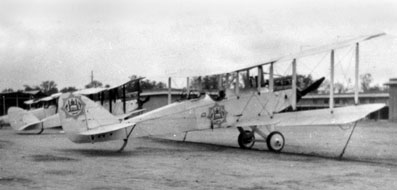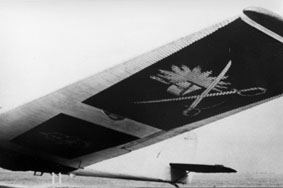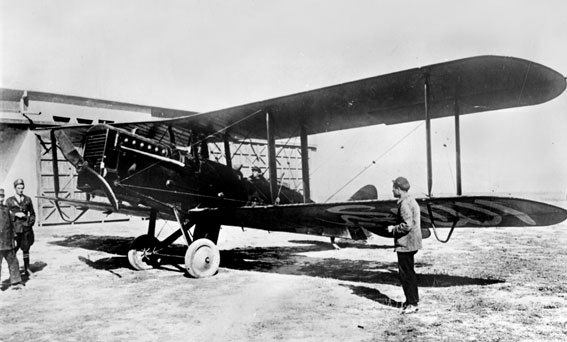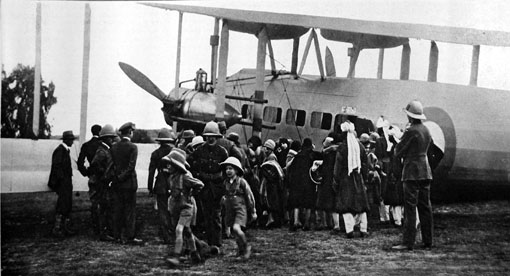 | ||
 |
 |
 |
 |
 |
|
The First 30 Years of Aviation in Afghanistan Part 1 © Lennart Andersson
An example of the Soviet-built copy of the Airco DH 9A, the R-1. The inscription under the lower wing reads "Allah-u-Akhbar".
The history of aviation in Afghanistan is more or less a "white spot". The reason is undoubtedly the county's inaccessibility, both geographically and politically. Old photos of aircraft in Afghanistan are extremely rare, finding detailed information is difficult, and consequently few publications have dealt with aviation in that country. As always, there are sources for research, however, although they may be difficult to find, and with unearthed information it is possible to outline the early history of aviation in the recently so war-torn and devastated country. Afghanistan has no navigable rivers and no railways. Road construction is difficult and costly because of the formidable mountain barriers and in the 1920s caravans of pack animals were often the only means of transportation. As in most such areas aviation promised to become one of the keys to economic advance. The country's leader amir Habibullah was murdered in February 1919 and his son Amanullah attempted an invasion of Indian territory during May-August. What was called the Third Anglo-Afghan War was inconclusive, but gained the Afghans their independence. The Treaty of Rawalpindi was concluded on August 8, 1919. Before signing the final document with the British in November 1921, the Afghans concluded a treaty of friendship and military aid with the new Soviet regime in Russia on February 28. In fact, Afghanistan was one of the first nations to recognise the Soviet government, and a special relationship between the two governments lasted until the Soviet invasion of December 1979. Amanullah changed his title from amir to padshah ("king’) in 1923 and inaugurated a decade of reforms, including constitutional and administrative changes, removal of the veil from women and coeducational schools. As we will see, this reformation of the society was in the event to lead to his fall from power. During the 1919 war No 31 Squadron, RAF, had attacked Afghan army units and the city of Jalalabad was bombed on May 19, 20 and 24. Perhaps making a greater impression, Captain Haley made a bomb raid on Kabul on May 24 with a Handley Page V/1500 bomber. On May 14, Afghan Minister for Foreign Affairs Makhmud Tarzi wrote to the Russian People's Commissar for Foreign Affairs, G V Chicherin, to ask for help against British bombings. Diplomatic relations was quickly established and an Afghan diplomatic mission was sent to Tashkent in June. They asked for three aircraft but although Lenin received the Afghans in Moscow in October and promised to send a special aviation unit to Kabul, nothing happened until after the end of the Civil War in Russia In July 1921 the Russians promised to deliver aircraft and other military equipment free of charge to the Afghan Government. In September three aircraft, an ancient Farman HF 4, a Nieuport 24 fighter and a two-seat Sopwith 1½ Strutter[i], were sent by train to Termez on the border to Afghanistan. The Farman was used for emergency observation flights and was shot down by rebels near Termez and destroyed, but on September 21, the transfer from Termez to Kabul of the two remaining aircraft, fuel, oil and spare parts started. A total of 25 Russian personnel were sent. V V Goppe, who had visited Kabul in advance, headed them. Fuselages and wings were loaded on horses, camels and elephants and after covering about 500 km of extremely difficult mountain routes through the Hindukush, the caravan arrived in Kabul on November 7. Pilot E Gorodetsky was already in Kabul and pilots K Baikov and Jakob I Zhurba, two observers and two mechanics arrived with the caravan. A landing ground had already been arranged and a hangar had been built. Some flying was done, but the planned selection and training Afghan pilots failed and the Russians soon returned home. Two more Nieuports were sent from Moscow on April 1, 1922, and a few more aircraft followed later in the same month together with new instructors for a flying school. In order to avoid what was described as "the unpleasant incident with the first party of pilots, who travelled in vain to Kabul and back", all personnel were to await further orders before crossing the border. The aircraft were to be handed over to Afghan representatives at Kushke, near the border to north-western Afghanistan. By mid-May it was apparent that the Afghan Government was reluctant to allow Russian personnel to come to Kabul. Even though these aircraft were probably never delivered, the Soviet Russian Government decided at the end of 1923 that they had fulfilled their part of the 1921 agreement. By December 1924 the Sopwith and the Nieuport fighter were still existant, although both were unserviceable. In the meantime other aircraft had arrived. A machine belonging to the RAF had gone down behind Afghan lines at Ghazni in Katawaz on January 15, 1921. It was inspected by Afghan military personnel in September and was found to be Bristol F.2B Fighter H1658. It was decided to move the aircraft to Kabul by elephant and to try to repair it. At about the same time two aircraft were ordered from Italy by the Afghan Government. These machines, referred to as "Caproni Scouts", or "single-seat Capronis with 6-cylinder Fiat engines", were shipped from Brindisi on the SS "Africa". They arrived in Bombay about June 20, 1922, but as the Afghans suspected that there was something wrong with the aircraft - and they were to be proved right! - it took some time before they could be landed. It was soon found out that the two Italian biplanes had been damaged before or during sea transport. Three Germans were later engaged to make the aircraft serviceable and they arrived in October but soon left again. By September 1924 an Italian engineer was trying to repair them, but according to a British intelligence report they probably never flew. Already in April 1920 an Oberleutnant Carl Menchoff, Neubabelsberg, Germany, told the Junkers Company that he had been engaged to set up an air force in Afghanistan. Junkers regarded the request with some suspicion, but quickly offered to deliver an example of the six-seat F 13 passenger transport. Nothing more was heard about these plans, however, but on February 2, 1922, Junkers offered via Menchoff to deliver to the Afghan Government single-seat fighters and two-seat reconnaissance aircraft. Junkers soon wrote, however, that due to the Versailles Treaty restrictions they could not build any military types. Since the end of 1922 Junkers kept contact with the Afghan Government through several representatives. These were von Niedermayer, Orient-Handels-Gesellschaft, Dr Iven, an instructor to the Government, and Abdul Qudus Khan, who had been trained as a pilot by Junkers at Tempelhof in Berlin. Abdul Qudus Khan was later engaged as an instructor in Kabul. Junkers also got in contact with Hauptmann Schütz, who had "since 1919 been organising the Afghan Air Force". For the time being no Junkers aircraft were ordered, however. In December 1922 two aircraft were purchased in Rangoon and they were to be delivered via Bombay to Kabul. A pair of two-seat Airco DH.9 biplanes were in Rangoon, but one was reported to be completely unserviceable and it seems that these aircraft never arrived in Kabul. In 1923 two German instructors were engaged, Hermann Weisz, a pilot, and a mechanic named Brustmann. It was intended to open an aviation school and Brustmann, who arrived in May, was asked to try to make the now long neglected aircraft serviceable again. He assembled and painted a couple of them, but one of the aircraft crashed during a take off attempt due to engine malfunction.
 The Afghan Government purchased two DH 9s and two Avro 504Ks from M C Aviation Syndicate in India in 1924.
First British Aircraft In May 1924 the Afghan Government requested six aircraft from the British Government in India: two bombers, two scouts and two trainers. The Kabul aerodrome had been completed, the two Germans were still present and two Afghan officers were training in Italy since 1922. The Government of India replied that two to four two-seat Bristol Fighter biplanes were available. On August 18, negotiations for the delivery of two such aircraft were successfully concluded and a contract was signed by Sardar Sher Ahmed Khan. On his request the phrase "Allah-u-Akbar" (God is Great) was painted in large Arabic characters under the wings of the aircraft as a sort of national marking. Both machines (E2600 and F4733) left Peshawar with Flight Officers N C Saward and F F Garraway at the controls and landed in Kabul on August 22. They were taken over on the following day after successful demonstrations by Wing Commander Johnston. Weisz flew a Bristol Fighter for the first time on August 24. Weisz then made ten flights in the rebellious Khost area, but on September 14 he had to make an emergency landing and crashed at Gardez. Because of the rebellion it was impossible to get spare parts to the site, so the aircraft was dismantled and brought back to Kabul on camels. Meanwhile Brustmann was trying to acquire necessary spare parts and tools to repair the captured Bristol Fighter, which was kept in a shed that had been built for it. In order to counter the delivery of the two British aircraft and gain the upper hand politically, the Russians now presented Afghanistan with five machines complete with pilots and mechanics. The Afghans seized the opportunity and requested seven more aircraft from the British and seven from the Russians! On October 1, four ex-Soviet Air Force DH.9s and one Junkers F 13 transport (c/n 666) arrived in Kabul after a flight from Tashkent via Termez over the Hindukush. The aircraft had served with the 2nd and 4th Independent Reconnaissance Aviation Detachments of the Soviet Air Force previously. The Russian personnel, who were to enter Afghan Air Force service, were headed by P Kh Mezheraup and consisted of pilots Yu N Arvatov, M M Garanin, V V Goppe, Ya Ya Yakobson and A I Zalevsky, and mechanics and observers S A Lisitsky, I I Sinyavsky, I V Svechennikov, M P Staroskol’tsev and E A Voinsky. Three of the new aircraft were demonstrated in the air on October 2, when leaflets and flowers were spread over the city. On October 26, a demonstration was made with two of them and on November 2, the Russian pilots were asked to undertake a bombing flight. As the terms of their contracts had not yet been settled they refused to do this. The first aerodrome had been situated at Khwaja Rawash, 3 miles to the north of Kabul, but in the autumn of 1924 a new aerodrome was constructed at Sherpur where all the bastions on the southern face of the city's cantonment had to be demolished. Seven hangars were built. In the meantime the Afghans were trying to get more aircraft from other sources. Already on Mach 31, 1924, a Captain Murphy of the M C Aviation Syndicate at Karachi had been contacted. The negotiations dragged on, but in September 1924 Murphy sold two DH.9s and two Avro 504Ks to the Afghan Government. These aircraft arrived at Peshawar, India, in December 1924, but were in fact not transferred to Kabul until in 1926. In March 1925 the Russians had sent a number of Sopwith 1½ Strutters to Kushke and intended to hand them over to the Afghan Government. A number of pilots, including Mezheraup and Moshkov, were detailed to go with the aircraft to Kabul, but apparently this operation was called off. In the spring of 1925 Muhammad Ihsan Khan graduated as a pilot in Italy and returned to Kabul. According to a British intelligence report, perhaps typical of the prejudiced attitudes of its time, he was "totally unfit" and was passed out from the Italian school "only to prevent his doing further havoc to the Italian training machines". Observer Muhammad Hashim Khan and mechanic Ghulam Dastgir, who had also been trained for three years in Italy, arrived home at the same time. By the summer of 1925 there were five Russian pilots and eight mechanics in Kabul. Brustmann had died (he was apparently killed by another German), and Weisz had decided to leave. Twenty-four-year old Muhammad Ihsan Khan had now been appointed Commandant of the Air Force. There was also an Indian pilot, A D Patwardhan. On September 2, a flying school with 15 students was opened and about ten other students were sent to the Soviet Union for training. According to an agreement signed on June 15, 1925, the Soviet Government promised to deliver more aircraft to Afghanistan. On July 4, six R-1s, the Soviet-built copy of the DH.9A, arrived from Termez. Two of them force landed and crashed on the way at Tashkurghan and Haibak, however. Six new Russian pilots, one observer and six mechanics arrived with the aircraft and entered Afghan Air Force service. It was rumoured that four ex-Soviet Fokker single-seat fighters were expected as well, but they never turned up. A flying display was held at Khwaja Rawash aerodrome on July 31. The public was allowed for the first time to go up in the aircraft, which were also inspected by Amanullah. The Junkers F 13 had been named "Abdul Ghaful", which was printed in large letters on the fuselage sides. The DH.9s, of which three now remained, were dark grey, the four recently arrived R-1s were khaki and all had "Allah-u-Akbar" painted under the wings. Flights were made by Amanullah, the War Minister and most of the officials present. A British intelligence report written on the occasion was full of admiration for the Russian mechanics and mentioned that the aircraft were "well rigged and well handled". The report went on to say that the Afghan Air Force is "to all intents and purposes a Russian service, and may, indeed, be regarded as a Russian advanced base". A total of 25 Afghans had now been sent to the USSR for training. At the end of August 1925 there were 26 Russian officers and men, and another six were awaited. Two more R-1s were expected, probably as replacements for the two that had force landed or crashed in July, and these aircraft arrived on October 15 with Russian pilots and mechanics. Amanullah was determined to extract four more aircraft from the USSR, which he considered due under the terms of the Afghan-Soviet Treaty. He was waiting for the Soviet-trained Afghans to return as qualified pilots and mechanics and had plans for an air force ultimately consisting of 36 machines. A serious problem was that all spares, fuel and oil had to be brought in from Termez and carried on camels or ponies. Existing roads were impassable for mechanical transport. Although the aircraft had no bomb racks or machine gun fittings some bombs had been dropped during the so-called Khost rebellion. The Air Force also fulfilled more peaceful duties. During Amanullah's stay at Kandahar in November 1925, it operated a liaison service between that city and Kabul, and in April-June 1926 an airmail service to Jalalabad was run during the King's stay there. 
German crew of the single Junkers G 24 and two Junkers F 13s included pilots Joas, Kneer and Rothe. Note the two flags that are painted on the underside of the wings.
By June 1926 all aircraft had a serial number written in large Arabic lettering and the Afghanistan coat of arms was painted in white on the sides of the fuselage. The phrase "Allah-u-Akbar" was written in large, white Arabic lettering on the bottom or each wing. The two DH.9s and two Avro 504 trainers that had been purchased from Captain Murphy and an additional Avro, that had been presented privately to the Afghan Government, were finally being brought to Kabul by road from Peshawar. As the aircraft had been stored for a long time it is doubtful if they ever became serviceable. They were painted in a light colour and had the crest of Afghanistan in a medium colour on the fuselage, wings and vertical tail surfaces. In May 1927 the Afghan Government requested the purchase of three "military photographic aircraft" stored in Lahore, probably DH.9s, from the Indian Maharaja of Alwar. The British authorities granted the request, but it seems that the deal fell through. Good aerodromes had been prepared at Kabul, Jalalabad and Kandahar, and one was in course of construction at Herat in mid-1926. According to a later French report dated August 1928, the large Kabul aerodrome then had 10 hangars for four aircraft each and a good repair shop. The Air Force uniform consisted of drab khaki coat and trousers and black boots, the coat having a large, sky-blue collar on which were a small brass star of rank and small brass wings. Experienced and efficient Russian pilots and mechanics were engaged on three years’ contracts. In 1927 the Soviet airline company Dobrolet decided to extend its Tashkent-Samarkand-Termez route to Kabul and the first proving flight was made on September 14. On November 28, the Afghan Government signed a general agreement with the USSR about a mail and passenger service between Kabul and Tashkent and an agreement between Dobrolet and the Afghan Air Force followed on March 7, 1928. The service was formally inaugurated on January 1, 1928, by Dobrolet's Junkers F 13 RR-DAZ "Pishchevik". By May 1928 only thirteen flights had been made by Dobrolet, however, and six by the Afghan Air Force F 13, and the service was temporarily closed. It was opened again for unscheduled operations in September 1928 and from the following month the route was flown by Junkers F 13s and Dornier Merkur R-RDAW "Pravda". Yu N Arvatov, who was considered to be the best Russian pilot, flew the Afghan F 13, which was now referred to as Junkers "No.1". By January 1928 nine Afghan pilots and five mechanics had returned from training in Moscow and three or four more were expected. Fifteen Afghan aviation students were in Paris and in March 1928 another 25 were sent to the Italian Regia Aeronautica Cadet College at Caserta, Rome, for training as pilots, observers and mechanics. New aircraft were delivered from the Soviet Union in 1928. On May 13, eight dark green and light blue R-1s with "Allah-u-Akbar" in black under the wings arrived in Kabul from Tashkent. One more had been lost on the way and was written off when it crash-landed at Parachindar. A tenth machine arrived in Kabul on May 14 and three more reached Kabul on June 1. The total number of R-1s delivered this time was 16. In the summer of 1928 Amanullah visited Europe and several governments decided to present aircraft and other types of arms as gifts to the Afghan King. In this way he acquired during the European tour, from Italy, two armoured cars (one as a gift), two field batteries, four howitzer batteries and two pack batteries; from Germany, one Junkers G 24 (a gift) and two Junkers F 13s; from France, a Potez 25 (a gift), two field batteries, one pack battery and five light tanks; from Poland, a Bartel BM 4b trainer (a gift); and from Russia, two aircraft (gifts), two tanks and two tractors. Junkers had earlier offered to deliver F 13s, A 35/K 53s, W 33s and G 24s. One offer was for a flying school at Kabul, complete with workshops, six F 13s, two K 53s, two trainers and two photographic aircraft, and in April 1928 Junkers was asked to develop domestic air transport services in Afghanistan. When Amanullah visited the Junkers factory at Dessau in May he purchased the two F 13s mentioned above (c/ns 2018 and 2019) and the German Ministry of Foreign Affairs presented a three-engine G 24 passenger transport (c/n 918) to him. All three aircraft left Dessau for Berlin and Moscow on June 15 and arrived in Kabul on July 10. These aircraft had the black Afghan flag with the coat of arms in white under the wings. In addition to the national flag, the G 24 also had the King's red flag with a pair of crossed swords and a cap. The G 24 was later registered YA-TMR[ii]. The Junkers aircraft were piloted by Walter Rothe, Georg Joas and Franz Kneer. Rothe had been engaged for two years and Joas was to stay in Afghanistan as well. Junkers representative H H Hagemann arrived in November to discuss the airline plans. It had been decided that Junkers would enter a definitive agreement and deliver additional aircraft in the form of two W 33s, if he found conditions suitable. Routes were planned to run from Kabul to Herat via Kandahar, Mazar-i-Sharif and Jalalabad. On August 22, the two-seat Potez 25 presented by the French Government arrived with Capitaine Weiser at the controls[iii]. Weiser and chief mechanic Clément had flown from Paris via Baghdad and Tehran.

|



